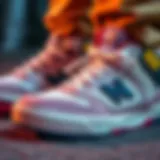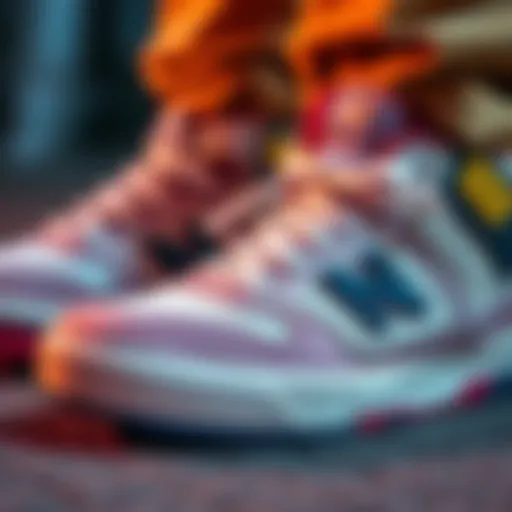Exploring Grip Tape: Key to Skateboarding Performance
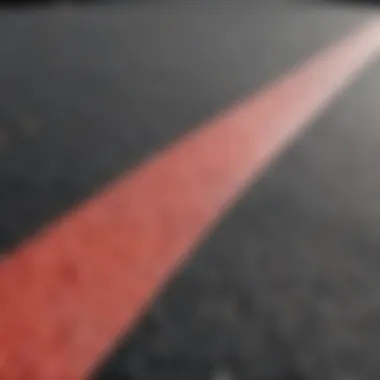

Intro
Grip tape is often the unsung hero of skateboarding. Many novice skaters might not realize its importance until they experience the slippery disaster of a neglected deck. Good grip tape is not merely a luxury; it’s a necessity that greatly influences performance and, quite frankly, rider safety. When skaters land tricks or navigate through their urban adventures, having a solid grip can be the difference between a well-executed ollie and a faceplant.
As we explore the world of grip tape, we’ll cover key aspects, including varieties, materials, and necessary considerations for different skill levels. From basic grip tape types to advanced designs that cater to experienced skaters, this journey will offer insights that empower riders to select the best product for their style and needs.
Skills Development
Skateboarding is all about honing skills, and understanding grip tape can directly impact your ability to master those skills.
Basic Tricks and Techniques
When starting out, skaters often focus on foundational tricks. A reliable grip tape enhances your chances of gaining those skills quickly. You'll want something that offers a rough texture while being forgiving enough for beginners.
- Ollie: The simplest trick to learn. Solid grip tape ensures your foot stays anchored during the jump.
- Shuvit: Requires great board control; again, grip tape helps keep your feet firmly on the board.
- Kickflip: A flick of the foot is paramount. With suitable grip tape, this maneuver becomes more manageable.
Advanced Maneuvers and Tips
For experienced skaters, grip tape becomes a more personal choice, often reflecting the skater’s style and technique. As you tackle complex tricks, grip tape can either be your best friend or your worst enemy.
- Heelflip: A trick that demands precision; using a tape with the right grit can offer the fine control needed for this move.
- Grinds and Slides: The smoother your tape, the better the slide. Some riders may prefer various textures for different grind styles.
- Technical Tricks: For maneuvers that require a light touch and swift movements, grip tape that offers both adherence and flexibility is essential.
Gear and Equipment Reviews
Choosing the right gear goes beyond just the board. Grip tape is an integral component that deserves attention.
Skateboards and Accessories
When selecting skateboards, consider the compatibility of the grip tape with your deck. Not all decks are created equal, and some grips might wear down faster than others. Many skaters often avoid cheap options, knowing that durability is critical in the long run.
- Mellow Grip Tape: Common among street skaters for its balance between grip and smoothness.
- Rough Grip Tape: Ideal for street and park skating, offering great traction for tricks.
- Custom Designs: For the skater who values aesthetics alongside performance, some brands offer personalized designs.
Safety Gear and Recommendations
Even with the best grip tape, safety should never take a back seat. Here’s a quick list of safety gear every skateboarder should consider:
- Helmet: Always wear one; it's non-negotiable.
- Wrist Guards: Help protect against falls, especially important for beginners.
- Knee Pads: Good for skaters tackling rough terrains or tricks.
- Elbow Pads: Add an extra layer of protection when learning new skills.
"A good grip tape does not just keep you glued to your board; it keeps you grounded in your passion for skating."
In wrapping things up, understanding grip tape is about more than mere material science. It informs your moves, enhances your safety, and ultimately shapes your entire skating experience. By choosing the right tape fitting your preferences and techniques, you set yourself up for success.
The Role of Grip Tape in Skateboarding
Grip tape is the unsung hero of skateboarding. It might not have the glitz of flashy deck designs or the flair of bright skateboard wheels, but make no mistake, grip tape plays a vital role in riding safely and effectively. It's the layer on top of the deck that connects the skater to the board, and that simple function is packed with implications. Let’s take a closer look at how grip tape does its job and why it’s so crucial for skaters of every level, from beginners just learning the ropes to seasoned pros pulling off jaw-dropping tricks.
Functionality of Grip Tape
Grip tape serves a single but important purpose: providing a texture that helps skaters maintain control and balance. When you’re gliding down the street or attempting a gravity-defying trick, the last thing you want is for your foot to slip off the board because that would lead to a nasty fall—and nobody wants that!
There’s no one-size-fits-all when it comes to grip tape functionality. Different types of grip tape can cater to diverse skating styles. For instance, a rough, aggressive grip tape might benefit street skaters who need solid footing for tricks and jumps on rough terrain. In contrast, smoother types can help vert skaters with more precise foot placements, allowing them to maintain stability while performing aerial maneuvers.
Moreover, it's not just about the grip. Quality grip tape also influences the overall feel of a skateboard. A well-chosen grip tape can enhance the rider’s responsiveness, making it easier to shift weight from toe to heel—a crucial element when executing turns or tricks.
Importance of Traction
Traction is where grip tape shines the most; it’s all about keeping your feet glued to your board. Think of it as the tires of a car—without good traction, everything is a risk. Poor traction can spell trouble, whether you’re cruising at high speed or navigating through tight spots.
A skater with good traction can confidently hit the pavement, but if that grip tape is failing or worn out, it can turn a fun ride into a hazardous excursion. This importance is magnified when you consider the factors at play during tricks. A small slip can often lead to serious spills.
For beginners, understanding and feeling that traction is essential. New skaters should choose grip tape that meets their comfort level while still providing the security they need to build confidence. As one progresses, they’ll learn to appreciate the nuances of traction offered by various grip tapes suited for different styles.
In summary, grip tape may not steal the spotlight, but its role in skateboarding is incredibly significant. From enhancing functionality to ensuring that skaters can ride with confidence, grip tape is foundational to the sport. When selecting grip tape, skaters are advised to consider their style, the kind of board they have and how these all contribute to their overall performance—because when it comes to skating, traction really is everything.
Types of Grip Tape Materials
When it comes to skateboarding, the type of grip tape used can significantly affect your performance and overall riding experience. Understanding the unique qualities of different materials allows skaters to make informed choices. Whether you are performing tricks, cruising on the street, or hitting a half-pipe, selecting the right grip tape material can up your game. From traction to durability, each material brings its own set of benefits that are worth considering.
Silica Sand
Among the most common materials used in grip tape is silica sand. This type of grit provides exceptional traction, which is paramount for any skater looking to maintain control. Silica sand grip tapes are often coarser, resulting in a textured feel underfoot. This texture translates into increased grip, making it easier to execute tricks without the fear of slipping off.
Skaters often find that the roughness of silica sand grip tape brings confidence to their riding, especially when tackling challenging moves. However, one should be mindful that rougher surfaces can suffer wear more quickly under high-pressure situations, such as grinding. In essence, while silica sand is a reliable grip option, understanding your riding style and conditions are key to making the right choice.


Grit Ratio
The grit ratio of grip tape refers to the size and amount of grit particles embedded in the tape. A higher grit ratio means more friction, which can lead to better grip. Conversely, a lower grit ratio may feel slippery, especially in wet conditions. It's this ratio that dictates how much stickiness you can expect from the tape.
Many manufacturers, like Grizzly and Mob, disclose their grit ratios, providing an opportunity for skaters to decide what fits their preferences. For instance, if you're someone who aims for maximum stability during trick execution, opting for grip tape with a higher grit ratio can make all the difference.
A good approach is to try different grit ratios to see which one enhances your performance while also considering factors such as environmental conditions and personal comfort.
Polyester vs. Rubber
Grip tape materials can mainly be divided into two categories: polyester and rubber. Each material has its own advantages and shortcomings. Polyester grip tape is generally more durable and resistant to wear and weather influences. It offers a more rugged surface that can withstand the demands of street skating or vert ramps.
On the flip side, rubber grip tape tends to be softer and provides a more forgiving feel underneath your shoes. This material is especially favored by skaters who prioritize comfort and grip in tricky maneuvers. The key, however, is to understand which material aligns with your skating style and needs.
Texture and Feel
When it comes to skateboarding, texture and feel of grip tape is like the unsung hero in shaping a rider's overall experience. The surface you stand on does more than just keep you glued to the deck; it plays a critical role in comfort, control, and the ability to perform tricks. Each skater has their own preferences, so knowing what to look for may tip the balance between sticking the landing and wiping out.
Smooth vs. Rough Surface
The age-old battle between smooth and rough grip tape surfaces demands attention. A smooth grip tape often provides less friction, offering a slicker feel. This comes in handy for those who prefer a slight give when shifting their feet during technical tricks. However, it's not suited for everyone, especially for beginners who might need that extra stickiness beneath their feet.
On the flip side, rough grip tape acts like Velcro, holding your feet firmly in place, making it easier to balance during tricky maneuvers. This can be particularly beneficial for street skating, where sudden stops and swift movements are a necessity. While rough tape may feel abrasive at first, many skaters find that it enhances their stability, especially during high-speed descents or jumps.
- Advantages of Smooth Grip Tape:
- Benefits of Rough Grip Tape:
- Easier foot adjustments for flips and spins.
- Greater speed for tricks requiring fluid motion.
- Increased traction for stability.
- Improved confidence in jumping and landing.
Skaters should explore both options before committing to a single type. Trying out different textures could lead to unexpected preferences, elevating one’s skating game to new heights.
Adaptive Feel for Tricks
Now, let’s get into the nitty-gritty of how grip tape’s texture can adapt during tricks. When executing flips, grinds, or slides, the adaptive feel becomes vital. A grip tape that allows for modification in feel throughout your ride can facilitate smoother transitions. A textured surface that reacts well under pressure can make all the difference in successfully landing those intricate trick sequences.
Some grip tapes are designed with varying grit levels, catering to the need for both grip and glide. This type of tape allows skaters to move in and out of tricks without feeling stuck on the board. Essentially, it's about finding that sweet spot where you can feel the board beneath your feet without it becoming an obstacle.
An ideal grip tape should offer:
- A consistent feel that adapts during movement.
- Traction that grips firmly during power moves but releases when less grip is required.
- Durability that ensures it maintains its performance, regardless of the array of tricks you throw at it.
"The difference in feel can compel skaters to push their limits and explore new tricks, ultimately refining their style."
Ultimately, a well-rounded understanding of texture and feel will empower skaters to make informed choices that align with their individual styles and preferences, enhancing their performance on the board.
Grip Tape for Various Specialties
When it comes to the various skating styles, many skaters ignore how grip tape plays a crucial role in their performance. Each specialty involves distinct demands, movements, and surfaces. Selecting the appropriate grip tape not only enhances safety but also tailors the skating experience to individual styles. Understanding the specifics can lead to significant improvements in performance and enjoyment.
Street Skating
Street skating often requires a robust grip tape that can withstand intense wear and tear. Unlike ramps or skate parks, the city environment presents a far less forgiving landscape, filled with rails, ledges, and rough terrain.
- Durability is Key: Street skaters benefit from grip tape that offers a high grit count. This means it provides better traction, allowing them to land tricks accurately on various surfaces without slipping off.
- Surface Adaptability: The variety of surfaces in urban settings can influence grip tape choice. For instance, grittier textures might be preferred as they help in executing technical pops, ollies, and grinds.
It's essential to research a grip tape that holds strong against debris, moisture, and the unpredictable nature of street obstacles. Brands that specialize in this area usually have test results backing their reliability, giving skaters peace of mind as they leap into action.
Vert Skating
When discussing vert skating, we step into a realm that embraces steep transitions and aerial maneuvers. Grip tape is more than just functional; it’s a matter of safety. Skaters often perform tricks at significant heights, and a solid grip ensures that their feet remain firmly planted on the board as they soar through the air.
- High Traction for Safety: A rougher grip tape surface aids skaters in maintaining stability during sudden shifts and spins. This can be vital when executing a hard trick or when sustaining balance while riding vertically.
- Personal Preference: Many vert skaters will try different textures, as some prefer a softer feel for easier foot adjustments, while others opt for the rough stuff for a maximum lockdown.
The right grip tape can provide the confidence needed to push one’s limits on a half-pipe or bowl. It’s about finding balance between comfort and security, preventing slips that could lead to injuries.
Longboarding
Longboarding presents a different set of challenges; it often emphasizes cruising over tricks, unlike street or vert skating. Grip tape for longboards is still essential, yet the priorities shift slightly. Skaters might look for control, stability, and even a bit of cushioning for their feet over raw grip.
- Smooth Yet Gritty: Longboarders may opt for grip tape that has a smoother surface while still ensuring that foot placement is secure. Techniques such as sliding and carving require a different type of security where grip tape shouldn’t be overly aggressive.
- Comfort is Crucial: Considering that longboarding often involves extended time on the board, a feel that prevents discomfort is key. This can involve selecting grip tape that adheres well without causing significant wear on shoes.
In essence, while the grip tape serves a foundational role in longboarding just as in other specialties, it's about striking the right balance between comfort, grip, and the unique demands of cruising.
"The right grip tape isn’t just an accessory; it’s a commitment to style, safety, and the embrace of every skating specialty."
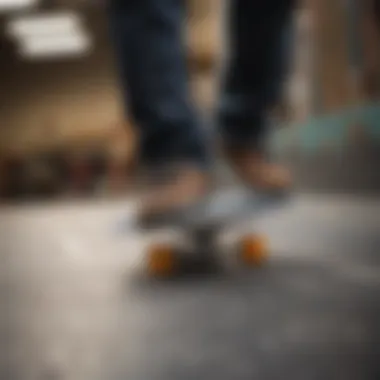

In summary, selecting grip tape is not a one-size-fits-all scenario. Skaters should take the time to consider the specialty they partake in and how grip tape complements their style and routine. Each skating variety calls for meticulous thought regarding the type of grip tape that can enhance their skills while ensuring safety.
Aesthetic Considerations
Skateboarding is as much about style as it is about skill. When it comes to grip tape, aesthetics play a crucial role in how skaters express their individuality. The grip tape isn’t just a functional accessory; it’s an extension of the rider’s personal flair. From intricate designs to striking colors, the visual appeal of grip tape can reflect the personality and preferences of the skater. This section explores how aesthetics impact the choice of grip tape and the overall experience on the board.
Prints and Designs
Custom prints and designs have become a game-changer in the world of skateboarding. Unlike decades ago, when grip tape was mostly black and plain, today’s market offers a veritable smorgasbord of patterns. From geometric shapes to artistic illustrations, the designs available are testament to the creativity within the skating community.
Choosing the right print isn’t just about looks; it can also impact the rider's mood and confidence while skating. A design that resonates with the skater’s vibe can make a session more enjoyable. Moreover, many companies now allow you to customize your grip tape with personal images or graphics. This customization fosters a unique connection between the skater and their board.
"Your board is your canvas; make it a masterpiece."
But not all designs are created equal. Some riders prefer a more minimalistic approach, opting for subtle patterns that don’t distract from their overall style. Others might go for loud, vibrant designs that demand attention. It’s essential to strike a balance between aesthetic appeal and functionality; a beautifully designed grip tape should still offer the necessary traction.
Color Variations
Color is a direct reflection of personality. The palette of grip tape on the market today ranges from the classic black to vibrant neon shades and everything in between.
The choice of color can evoke different feelings and responses. For example:
- Black: Timeless and versatile, it tends to give off a serious vibe.
- Bright Colors: Energetic and eye-catching, they can lift the spirit and excite the rider.
- Pastels: A softer look that can convey a more laid-back attitude.
For the skater wanting to make a statement, incorporating bright colors can really pop on the board, especially when paired with striking dress styles or outfits. Additionally, color can also foster a sense of community; certain colors or combinations may be associated with specific skate parks or groups of skaters.
While aesthetics are important, it’s crucial to ensure that the colors chosen don’t compromise the visibility of the skateboard as a whole. Riders often find themselves in situations where visibility is paramount for safety, especially in crowded areas or during low-light conditions.
Ultimately, choosing grip tape with the right prints and colors isn't just about making the board look good, it's about how it contributes to a skater’s identity and confidence on their skateboard.
Common Misconceptions
When discussing skateboard grip tape, certain myths can make the rounds. These misconceptions can lead skaters to make poor choices that might affect their performance, safety, or overall skating experience. Addressing these myths is essential for those who want to make informed decisions. It's not just about choosing something that looks cool; it’s about knowing what works best for specific needs and preferences.
Thicker is Better
One prevalent belief among skaters is that thicker grip tape translates to better grip and control. Some folks think that if the tape feels more substantial, it must be superior. However, that's not entirely the whole picture. While thickness can provide a cushiony feel underfoot, it doesn't necessarily mean you’ll have more grip. Sometimes, a thicker layer might hinder precision and feel, making it tricky to connect with the skateboard during trick execution.
Consider the grip tape's texture, grit, and material as significant factors in how well the tape performs. A balance must be struck. For instance, skateboards used primarily for street skating often benefit from a grip tape that is fine enough to let the skater feel the board while still offering the necessary adhesion.
Another element to think about is weight. A thicker grip tape can add unnecessary weight to your board, which may not suit everyone, especially if you lean towards flip tricks that require a lighter setup.
"Choosing the right grip tape means understanding your own style and preferences more than just blindly following trends."
Durability vs. Performance
Another common pitfall is the assumption that more durable grip tape will always lead to better performance. In reality, durability often comes with trade-offs. Heavy-duty grip tapes might last longer but can sacrifice the subtlety required for fine-tuned maneuvers. Riders who go for elaborate tricks or complex foot placements could find that super sturdy grips might not allow the flexibility or feedback they need.
Conversely, opting for lighter grip tape could enhance a skater’s feel for the board, improving their overall control. This doesn’t mean one should compromise on quality; it’s crucial to find the right grip material that balances durability with performance. Lightweight tapes might wear out faster, but they can also provide the feedback some skaters crave.
As with many things in life, it’s about finding the right fit. Thus, consider testing different brands or types. It can make a world of difference in skating performance.
Installation and Maintenance
When it comes to grip tape for skateboards, the significance of installation and maintenance cannot be overstated. Proper application ensures that the grip tape not only performs well but also lasts longer, ultimately enhancing the overall skateboarding experience. A well-installed grip tape means the difference between a smooth ride and an unsteady performance that could lead to accidents. From maximizing grip to extending the longevity of your tape, understanding how to effectively install and maintain grip tape is crucial.
Applying Grip Tape
Applying grip tape may seem straightforward, yet there are nuances that, if ignored, could lead to suboptimal performance. It's not just about slapping some tape on your board. In fact, the method you choose can make all the difference.
Steps to Apply Grip Tape:
- Preparation: Start by cleaning the skateboard deck thoroughly to remove dust and grease. Any leftover residue can hinder adhesion.
- Measurement: Carefully measure the grip tape to ensure it fits your board. If it hangs over the sides, it can catch on obstacles.
- Peeling: Slowly peel off the backing of the grip tape, exposing the adhesive. Take care not to touch the sticky side with your fingers to maintain its glue quality.
- Alignment: Position the tape at the back of the board, aligning it with the tail.
- Adhesion: Once aligned, press down firmly, starting from the center and working your way outward, preventing air bubbles. It's wise to use a roller or a flat object to smooth out any trapped air and ensure proper adherence.
- Trimming: After the tape is firmly in place, use a sharp knife to trim any excess tape for a clean finish.
These steps help create a secure bond between the grip tape and the skateboard, reducing the risk of lifting during rides and tricks.
Cleaning Techniques
Maintaining the performance of your grip tape goes hand in hand with proper cleaning. Over time, dirt and debris accumulate on the tape, hindering its grip. Here are some effective techniques to keep your grip tape in top condition:
- Regular Brushing: Utilize a stiff-bristled brush to sweep away any loose dirt or dust. A quick once-over after skating can prevent buildup.
- Soap and Water Solution: For deeper cleaning, use a mixture of soap and water. Make sure to wring out any excess liquid from your cloth before applying it to avoid saturating the tape—too much water can lead to peeling or damage.
- Avoid Harsh Chemicals: Steer clear of commercial cleaning solutions that contain bleach or strong solvents; these can degrade the adhesive or compromise grip quality.
"Keeping your grip tape clean is like giving your skateboard a fresh pair of shoes; it maintains its performance and keeps the ride smooth."
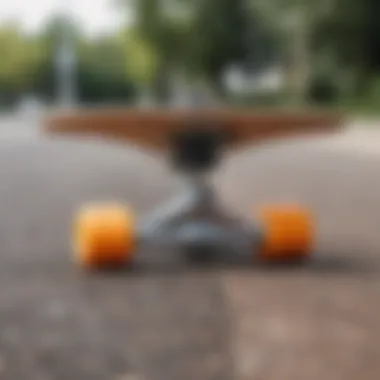

Being vigilant about installation and maintenance not only enhances the lifespan of your grip tape but also promotes a safer, more enjoyable skating experience. The fewer concerns you have about your grip, the more focus you can put on perfecting those tricks. Embrace the little things, and your board will thank you.
Evaluating Grip Tape Performance
When it comes to skateboarding, the finer points often make the most substantial difference. Evaluating grip tape performance digs into how well a skateboard's surface adheres to shoes, influencing both safety and trick execution. A performance-focused approach to grip tape not only enhances the rider's experience but also paves the way for more confidence during maneuvers. Key aspects to consider include traction, wear, and overall responsiveness.
Testing Traction
Testing traction involves assessing how well grip tape holds a rider's footwear under various scenarios. This doesn’t solely mean taking a few runs at the skatepark. Skateboarders should put their grip tape through its paces with a mix of tricks—ollies, kickflips, and even simple rides.
Here are some practical ways to conduct traction tests:
- Dry Runs: Start with dry conditions. Is there a noticeable slip when jumping or shifting weight?
- Moisture Factor: How does the tape perform on a slightly damp surface? This is vital as skateboarders often find themselves riding in different weather.
- Scuff Test: Performing tricks like slides can offer insight into how the grip tape holds up against friction. A tape that wears out too quickly can lead to hazardous slips and accidents.
Results of such tests can reveal whether the grip tape is truly up to snuff or if skaters should rethink their choice. Beyond just one-off testing, making a habit of observing performance can guide future purchases.
User Experience Feedback
User experience feedback is paramount. Real users' insights can shed light on aspects of grip tape that numbers alone might miss. Experience shapes opinion, and what works for one skater might not sit right with another. Consistent feedback can lead to shared understanding amongst the community about what to expect from certain brands or types of grip tape.
Collecting feedback can be done in several ways:
- Surveys and Polls: Platforms like Reddit can be excellent resources for gathering opinions. You can ask direct questions—"How does your grip tape perform during tricks?"
- Social Media: Engaging with skaters on Facebook can generate varied responses. People will often share their experiences in comments, offering a wealth of information.
- Skate Shops: Discussing experiences with local skateboard shop owners often reveals practical knowledge. These folks usually have seen various tapes in action and heard customer reviews that can provide valuable context.
In summary, both testing traction and collecting user feedback form a crucial loop in reaching an informed decision about grip tape. Performance evaluation is not a one-and-done deal; it evolves as skaters become more attuned to their equipment. Continual reassessment of grip tape's performance could lead to enhanced safety and elevated skateboarding skills.
Cost vs. Quality
When it comes to grip tape for skateboards, the age-old saying "you get what you pay for" rings particularly true. Understanding the relationship between cost and quality is crucial for skaters at all levels—whether you're a novice just starting out or a seasoned pro looking to optimize your setup. Grip tape plays an essential role in skating performance, and its importance cannot be overstated.
The right grip tape can enhance your board control, while the wrong choice can leave you slipping and sliding all over the place.
Skaters need to consider several factors when weighing their options:
- Material and Texture: Higher-quality tapes typically use better materials and advanced textures that provide superior grip and durability.
- Longevity: Cheaper options may wear out quickly, resulting in a need for frequent replacements which can cost more in the long run.
- Performance: A quality grip tape can boost your confidence while riding, especially when trying new tricks.
"Choosing grip tape is like picking a partner in crime. It can lift you up or leave you high and dry."
This section aims to shed light on various budget options and premium brands, helping you make a more informed decision without breaking the bank or sacrificing performance.
Budget Options
For those on a tight budget, finding decent grip tape that doesn’t sacrifice too much quality is possible. It's important to realize that just because something is cheaper, it does not mean it has to be poor-performing.
Some notable budget options include:
- Apex Grip Tape: While affordable, Apex offers a solid grip that lasts compared to other low-end options.
- Mini-Logo Grip Tape: This brand is known for its no-frills approach and decent traction without emptying your pockets.
- Element Grip Tape: A good blend of value and performance, Element grip tape can provide sufficient traction and durability for standard skating needs.
When selecting budget options, keep in mind the importance of doing some research. Look for user reviews and feedback from fellow skaters to ensure you’re not just buying the cheapest tape around.
Premium Brands
For those willing to splurge a bit on their grip tape, premium brands often have specialized offerings that can enhance your skatin experience significantly. While they come at a higher price point, the benefits can outweigh the costs.
Some renowned premium grip tape brands include:
- Jessup: Considered a benchmark in the industry, Jessup grip tape is favored by many for its exceptional durability and grip. Users often praise its performance during complex tricks.
- Black Diamond: Offering a vast range of textures and more innovative options, Black Diamond focuses on high performance and durability, ideal for serious skaters.
- Mob Grip: A fan favorite, Mob Grip is known for its outstanding grip and versatility, allowing skaters to execute tricks with confidence.
Ultimately, investing in premium grip tape can yield a rewarding experience, especially for those who frequently ride. Skaters often discover that premium options provide not just better grip but feel underfoot, resulting in a more enjoyable ride.
End and Recommendations
As we wrap up this exploration on grip tape, it becomes clear that making informed decisions in this realm profoundly influences not only performance but also the overall enjoyment of skateboarding. Grip tape may seem like just a small component, yet it can play a significant role in a skater's confidence and skill development.
In selecting grip tape, consider both functionality and aesthetics. While the right texture and material can enhance traction during daring tricks or casual rides, the visual appeal of the grip tape can also reflect individual style. A vibrant or uniquely designed grip tape might just be the perfect cherry on top for your deck.
Finding the Right Match
Choosing the right grip tape isn't merely about picking whatever looks cool. The best grip tape for one skater might not suit another. Factors like skill level, style of skating, and personal preference are paramount. Here are some considerations to bear in mind:
- Skill Level: Beginners might need grip tape that focuses on maximum traction to help with balancing, while more seasoned skaters may favor a smooth feel for easier foot adjustments during tricks.
- Type of Skating: Those involved in street skating might require a more robust grit for better grip during incredibly demanding stunts. Conversely, vert skaters might prefer something that offers more cushioning while still enabling solid contact with the board.
- Environmental Conditions: Think about where you usually skate. If you be doing tricks in wet weather, finding a grip tape that adheres well in moisture can save you from accidents.
Finding the right match can heighten your confidence and create a better, more enjoyable skateboarding experience.
Future Trends in Grip Tape
In recent years, the grip tape market has witnessed innovations that point toward exciting developments. As skateboarding culture continues to expand, here are some trends to keep an eye on:
- Eco-Friendly Materials: With an increasing emphasis on sustainability, some brands are experimenting with biodegradable grip tape or those made from recycled materials. This shift not only appeals to environmentally conscious skaters but also pushes the industry toward more responsible manufacturing practices.
- Smart Grip Tape: Imagine facing a tech-infused world where grip tape reacts to movements or adjusts its adhesive properties based on factors like speed or surface condition. While this sounds futuristic, it might not be too far off, as tech-savvy companies explore integrating sensors into grip tape for performance analytics.
- Customization Options: As personalization becomes more prevalent in various areas of consumer goods, we can expect a rise in customizable grip tape. Skaters might soon have options to create their designs, injecting their personality into their boards uniquely.
Ultimately, as we look ahead, the landscape of grip tape is ripe for transformation. From materials to functionality, advancements promise to make skating experiences even more rewarding. By staying informed and flexible, skaters can find solutions that not only enhance performance but also align with their values and style.
